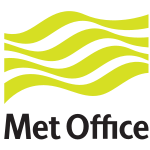Met Office

Logo of the Met Office (at 2009)
|
|
| Agency overview | |
|---|---|
| Formed | 1854 |
| Jurisdiction | United Kingdom |
| Headquarters | Exeter, Devon |
| Agency executive | |
| Parent agency | Department for Business, Innovation and Skills |
| Website | MetOffice.gov.uk |
The Met Office (officially the Meteorological Office until 2000) is the United Kingdom's national weather service. It is an executive agency and trading fund of the Department for Business, Energy and Industrial Strategy led by CEO, Rob Varley and chief scientist, Professor Stephen Belcher. The Met Office makes meteorological predictions across all timescales from weather forecasts to climate change.
The Met Office was established in 1854 as a small department within the Board of Trade under Vice-Admiral Robert FitzRoy as a service to mariners. The loss of the passenger vessel, the Royal Charter, and 459 lives off the coast of Anglesey in a violent storm in October 1859 led to the first gale warning service. FitzRoy established a network of 15 coastal stations from which visual gale warnings could be provided for ships at sea.
The new electric telegraph enabled rapid dissemination of warnings and also led to the development of an observational network which could then be used to provide synoptic analysis. The Met Office started in 1861 to provide weather forecasts to newspapers. FitzRoy requested the daily traces of the photo-barograph at Kew Observatory (invented by Francis Ronalds) to assist in this task and similar barographs and as well as instruments to continuously record other meteorological parameters were later provided to stations across the observing network. Publication of forecasts ceased in May 1866 after FitzRoy’s death but recommenced in April 1879.
Following the First World War, the Met Office became part of the Air Ministry in 1919, the weather observed from the top of Adastral House (where the Air Ministry was based) giving rise to the phrase "The weather on the Air Ministry roof". As a result of the need for weather information for aviation, the Met Office located many of its observation and data collection points on RAF airfields, and this accounts for the large number of military airfields mentioned in weather reports even today. In 1936 the Met Office split with services to the Royal Navy being provided by its own forecasting services.
...
Wikipedia
